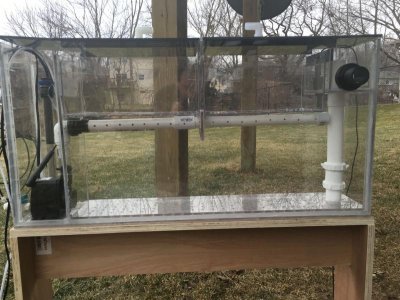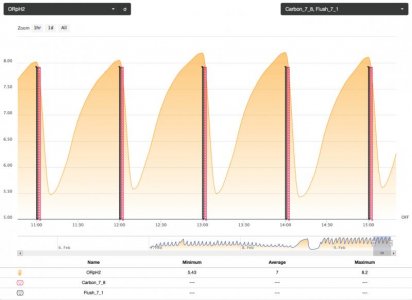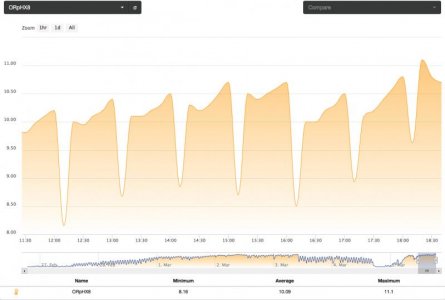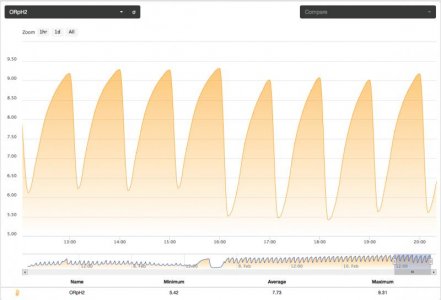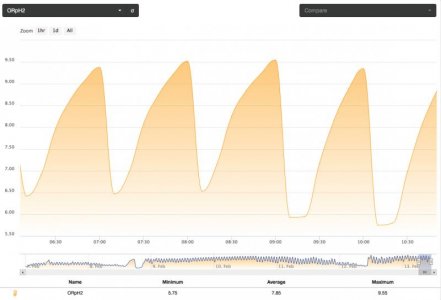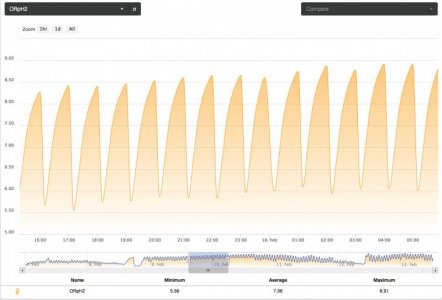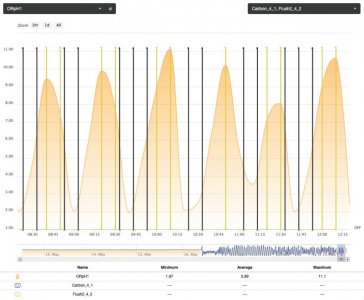Can you repost that graph. It doesn't show up in the post, or at least, I can't see it.
I looked at Klaus's graph of the water treatment system and it shows the same thing you are describing but I believe this was a fresh water reference, not salt so I am not sure how things will translate. In that graph the knee occurs at -30 mV.
I got the quinhydrone calibration solutions yesterday and ran a quick calibration (more of a practice than real calibration). I plan to do a good one today. Apex has advised me that the calibration factors, (an offset and slope) are stored in the channel and will remain until overwritten. I should be able to change the type to ORP, calibrate and then change back to pH and have those factors remain. We will see.
Also the filter is already starting to clog again. I am going to try once more time, removing the media and installing a bigger process pump. I got a Silent 1.5, which has a similar footprint to the one I am currently using but much better flow. I am also going to switch to a vinegar / CaOH mix (50/50) for my carbon solution. If these changes don't prevent the clogging, I am not sure where to go next. It seems that the more efficient pump has actually caused the clogging to occur faster.
Despite all the issues, I set up the Dingo Down version yesterday. I repurposed bio balls for my course media and used a 400 gph process pump. I made a few design changes. The lids are "showers" to defuse the water flow. Two trays will hold the sand so they can be easily removed. I added a heater and temp probe but it doesn't look like I will need it. I also moved the ORP probe and fitting to the overflow area for easier access.
Aaron
I looked at Klaus's graph of the water treatment system and it shows the same thing you are describing but I believe this was a fresh water reference, not salt so I am not sure how things will translate. In that graph the knee occurs at -30 mV.
I got the quinhydrone calibration solutions yesterday and ran a quick calibration (more of a practice than real calibration). I plan to do a good one today. Apex has advised me that the calibration factors, (an offset and slope) are stored in the channel and will remain until overwritten. I should be able to change the type to ORP, calibrate and then change back to pH and have those factors remain. We will see.
Also the filter is already starting to clog again. I am going to try once more time, removing the media and installing a bigger process pump. I got a Silent 1.5, which has a similar footprint to the one I am currently using but much better flow. I am also going to switch to a vinegar / CaOH mix (50/50) for my carbon solution. If these changes don't prevent the clogging, I am not sure where to go next. It seems that the more efficient pump has actually caused the clogging to occur faster.
Despite all the issues, I set up the Dingo Down version yesterday. I repurposed bio balls for my course media and used a 400 gph process pump. I made a few design changes. The lids are "showers" to defuse the water flow. Two trays will hold the sand so they can be easily removed. I added a heater and temp probe but it doesn't look like I will need it. I also moved the ORP probe and fitting to the overflow area for easier access.
Aaron

